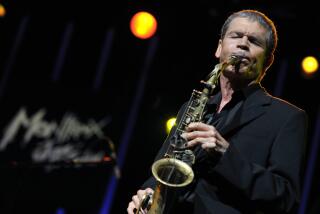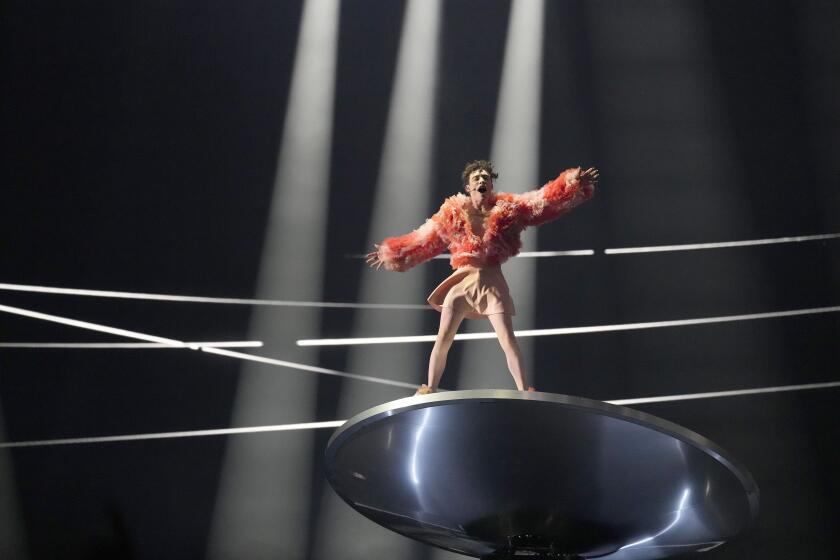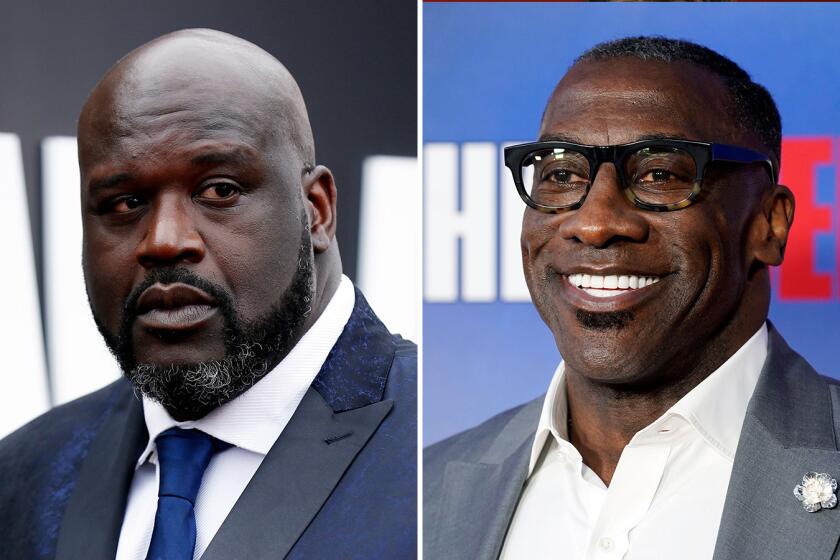Female Musicians Still Struggle for Acceptance : ‘Battle-weary’ players such as Jane Ira Bloom wonder if ability counts
The past week has been a hectic one for Ann Patterson. She has been checking on the music that will be needed for two important dates--Monday at the Biltmore Hotel’s Grand Ave. Bar, and Sept. 22 at the annual jazz festival in Sedona, Ariz.--and phoning the 16 other artists needed for rehearsal and performances.
Patterson is not a singer; not a dancer, pianist or comedian. She plays the saxophone and is the leader of Maiden Voyage, a 17-piece orchestra that has had a fits-and-starts existence for the past decade. Those phone calls are urgent, because it is difficult to make last-minute changes in a band that is all-female. (You might wind up, God forbid, with a male sub in the trombone section.)
The career of Ann Patterson symbolizes the hazards that have plagued women instrumentalists since the dawn of jazz. Just as black musicians for decades played only in all-black bands, female musicians often wind up surrounded exclusively by women.
The public has always accepted female pianists; women are also tolerated on instruments deemed suitably feminine--harps, violins, cellos--but horn blowing has been thought unladylike.
“I remember once,” trombonist Betty O’Hara said the other day, “I was in line for a good job in Hartford, Conn., until the bandleader said, ‘We can’t have a woman in this orchestra. That makes it look bad.’ ”
O’Hara is among the lucky few who have overcome. She has had her share of studio jobs, still plays jazz gigs (she will be at the Classic Jazz Festival over Labor Day weekend at the Airport Marriott). As the senior member of Maiden Voyage she displays her multiple talents, playing trombone, fluegelhorn and a double-belled euphonium, singing and contributing her own arrangements.
“Women playing jazz are still looked on with a jaundiced eye,” says O’Hara, “but today they are so skilled and have so much more confidence that things can’t help but improve.”
Patterson also feels optimistic. “Maiden Voyage only works a few times a year, mainly because I don’t have the time to devote to lining up work. Between studio gigs, casuals, jobs and shows, woodwind quartet dates with Ira Schulman and clinics at schools, plus the occasional chance to play with a big band like the Frank Capp-Nat Pierce Juggernaut, I have no trouble paying my bills. Things are better; there’s less resistance to women.”
Still, it is odd that there is so little demand (and no record contract) for Maiden Voyage, an ensemble so intriguing to the Pulitzer Prize-winning classical composer Mel Powell that he wrote a jazz suite for the band and organized a performance at CalArts, where he is a faculty member.
Stacy Rowles, the brilliant fluegelhorn and trumpet soloist, had such a chaotic career that for a couple of years she was obliged to take a day job in a store. “Stacy is finally getting to work regularly,” says her father, the eminent pianist Jimmy Rowles. “This week she’s away on an Alaskan cruise with Red Holloway’s group. For two years she’s toured off and on in the U.S. and Europe with the Jazz Tap Ensemble show. She works now and then with the Jazzbirds, a quintet of musicians out of the Maiden Voyage band. But aside from one call from Nelson Riddle, I can’t remember her getting any of those good-paying studio jobs.”
For some of the young musicians, the outlook is less bleak. Drummer Terri Lyne Carrington, 25, has been heard mainly with male bands since trumpeter Clark Terry hired her when she was 15. She just completed a two-month tour with Stan Getz, and will leave soon for a four-week jaunt in South America, leading her own group under the aegis of the State Department.
Carrington has even had the rare experience of being hired because of her gender rather than in spite of it. When “The Arsenio Hall Show” bowed, she was a member of Michael Wolff’s house band. “I had heard Arsenio was looking for a female drummer,” she says. “But some people don’t want to take any risks; there’s still a lot of chauvinism around. You just do your best to combat it; some women are bitter, but I don’t believe in wasting my time on negative energy.”
As Carrington’s case bears out, many avenues are opening up. Two years ago, the veteran tenor saxophonist Joe Henderson went on tour backed by a rhythm section composed of Renee Rosnes, the vitally creative pianist from Vancouver; Cindy Blackmen, a promising drummer, and Marlene Rosenberg on bass. Rosnes, like Geri Allen and other young pianists, works mainly with male groups.
Historically, the first (and almost only) member of her sex to crash the brass barrier was Melba Liston, a trombonist and composer who in the 1940s toured with the bands of Gerald Wilson, Dizzy Gillespie and Count Basie.
Some women have taken extraordinary measures to secure work. Last winter, trumpeter Clora Bryant wrote a personal letter to Mikhail Gorbachev, and three months later was rewarded with concert dates in Moscow and Leningrad.
Discrimination, more often covert than overt, has driven many women out. Vi Redd, whose alto sax solos once elicited standing ovations in London and around Europe, settled for a career as a schoolteacher; she now plays only occasional dates.
Jane Ira Bloom, who graduated from Yale in 1977, by which time she had been a professional saxophonist for two years, has mixed feelings. A vanguardist who has experimented with electronics, she is under contract to Columbia Records; as a composer she was commissioned by NASA to write a special work commemorating a space launch. Her career seems to indicate bright horizons and upward mobility, yet she has doubts.
“I’m surprised at how slowly things have been moving in the 15 years since I started playing. It’s common to women of my generation to feel this way, not only in music but in all kinds of fields.
“How do you know when you didn’t get a job? The phone calls don’t come, and you can’t put your finger on the reason. We expected so much that hasn’t materialized. There is a battle-weary group of women players out there who are tired of being asked how it feels to be in this profession; it honestly wears you down after a while.
“We thought musical ability would be rewarded, along with critical acceptance, but transferring critical success into economic success is another matter. And if your music is branded as too unique or progressive, that’s another strike against you. Promoters and record companies find a strong, innovative statement coming from a woman hard to accept. In retrospect, I realized that if I wanted to succeed, I had to be a leader, a producer, a composer and a road manager as well as a player.”
Bloom’s comments apply exactly to the case of Toshiko Akiyoshi. Although she won several Down Beat polls as composer, arranger and big-band leader (the first woman and first Asian ever to win in any of these categories), she has been unable to secure more than three months’ work a year for her widely praised orchestra.
One wonders how these problems affect the potential influx of women into a male-dominated world. Tom Riley, assistant to the president of Berklee College of Music in Boston, had some disturbing statistics.
“Out of our enrollment of 2,803, about 16%, or 454, are women--about 43% are voice majors and 27% are piano majors. Only 7% are studying saxophone, 4% flute, 3% bass and just 2% brass instruments.”
How many of those students, some of whom will surely emerge with a genuinely promising talent, can hope to be making their living in jazz, or in any other genre of music, in the year 2000? How often will the telephone ring for them, how many will abandon hope?
More to Read
The biggest entertainment stories
Get our big stories about Hollywood, film, television, music, arts, culture and more right in your inbox as soon as they publish.
You may occasionally receive promotional content from the Los Angeles Times.






